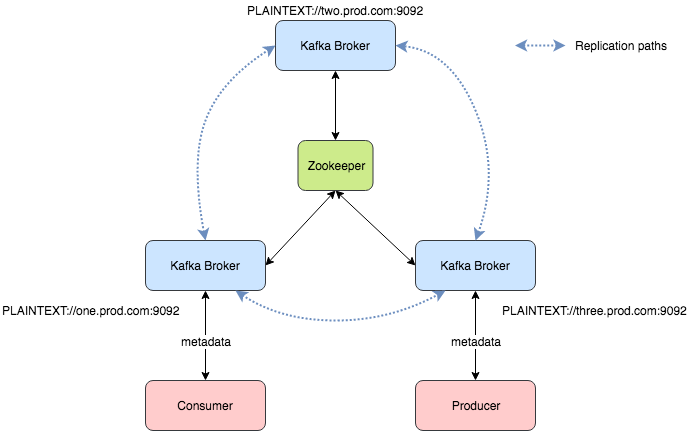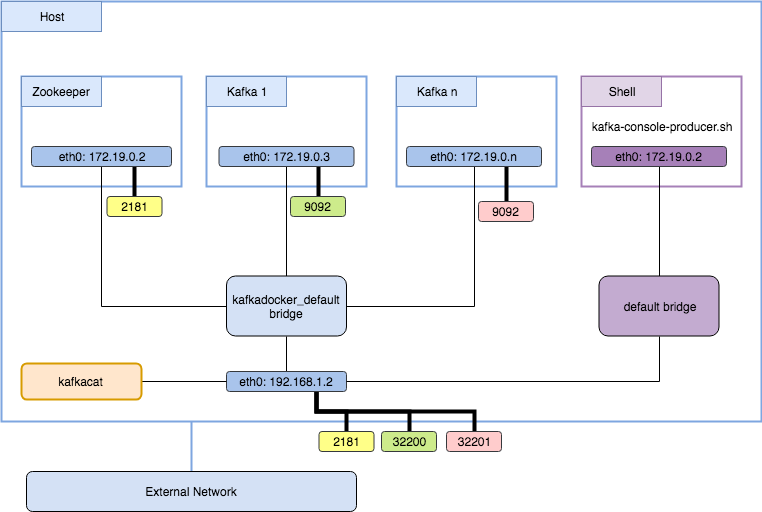-
Notifications
You must be signed in to change notification settings - Fork 2.7k
Connectivity
A large percentage of questions and issues opened against the kafka-docker project concern configuring Kafka networking. This is often a case of not understanding the Kafka requirements, or not understanding docker networking.
This page aims to explain some of the basic requirements to help people resolve any initial issues they may encounter. It is not an exhaustive guide to configuring Kafka and/or Docker.
There are three main requirements for configuring Kafka networking.
- Each Broker must be able to talk to Zookeeper - for leader election etc.
- Each Broker must be able to talk to every other Broker - for replication etc.
- Each Consumer/Producer must be able to talk to every Broker - for reading/writing data etc.
The following diagram represents the different communication paths:

This means for a complete working Kafka setup, each one of the components must be able to route to the other and have accessible ports.
First, let's take a look at the simplest use-case - running a single Kafka broker.
# KAFKA_ADVERTISED_HOST_NAME: localhost
# ZOOKEEPER_CONNECT: zookeeper:2181
docker-compose -f docker-compose-single-broker.yml up -d

Two containers are created which share the kafkadocker_default bridge network created by docker-compose. Here you can see both ports from the container are mapped directly to the host's network interface (2181 and 9092)
NOTE: When using docker-compose, all containers are generally started in the same networking namespace. I say 'generally' as you can configure multiple networks, but we're sticking to the simple use-case here.
In this setup all Kafka requirements are met:
- the Kafka container can talk to Zookeeper via the
zookeeperDNS entry that exists within thekafkadocker_defaultnetwork - the Kafka container can talk to itself on
localhost:9092(within the containers networking namespace) - Consumers and Producers can talk to the Kafka broker using
localhost:9092address. This is because docker will generally bind the port to all interfaces (0.0.0.0) when it is published.
$ docker ps
CONTAINER ID IMAGE PORTS NAMES
1bf0d78a352c wurstmeister/zookeeper 22/tcp, 2888/tcp, 3888/tcp, 0.0.0.0:2181->2181/tcp kafkadocker_zookeeper_1
d0c932301db5 kafkadocker_kafka 0.0.0.0:9092->9092/tcp kafkadocker_kafka_1
Next, let's look at the common use-case - running multiple Kafka brokers.
# KAFKA_ADVERTISED_HOST_NAME: 192.168.1.2
# ZOOKEEPER_CONNECT: zookeeper:2181
docker-compose up -d zookeeper
docker-compose scale kafka=2

Here, the key differences are two configurations in the docker-compose.yml file; ports and the KAFKA_ADVERTISED_HOST_NAME environment variable.
Because it is only possible to bind to each unique port once on a single interface, we can no longer publish the Broker port (9092). Instead, we simply expose the port.
ports:
- "9092"
This results in docker binding an ephemeral port on the host interface to the container port.
$ docker ps
CONTAINER ID IMAGE PORTS NAMES
2c3fe5e651bf kafkadocker_kafka 0.0.0.0:32000->9092/tcp kafkadocker_kafka_2
4e22d3d715ec kafkadocker_kafka 0.0.0.0:32001->9092/tcp kafkadocker_kafka_1
bfb5545efe6b wurstmeister/zookeeper 22/tcp, 2888/tcp, 3888/tcp, 0.0.0.0:2181->2181/tcp kafkadocker_zookeeper_1
This should hopefully explain why we had to use the hosts interface address in the KAFKA_ADVERTISED_HOST_NAME environment var. Let's cement this understanding by adding consumers / producers to the diagram:

This explains why all Kafka requirements are met:
- The Kafka containers can still use the
zookeeperDNS entry to talk to zookeeper in thekafkadocker_defaultnetwork - The Kafka containers can talk to each other by routing from the
kafkadocker_defaultbridge network to the listening host interface (192.168.1.2:32000and192.168.1.2:32001) - Consumers and Producers and also talk to the Kafka containers by the host interface (
192.168.1.2:32000and192.168.1.2:32001)
NOTE: It is worth pointing out that the kafka-console-producer.sh shell container is started on the default bridge because it was simply started with the docker run command (see the start-kafka-shell.sh script)
For completeness, here is a kafkacat example:
# Publish
kafkacat -b 192.168.1.2:32000,192.168.1.2:32001 -P -t test
# Consume
kafkacat -b 192.168.1.2:32000,192.168.1.2:32001 -C -t test
The following is a little more background information, optional, but supplementary to the above documentation.
Kafka has always had the notion of an 'advertised' host and port. This is a mechanism to allow the public address of a node (i.e. DNS record) to be different to an internal address. This is especially useful if you have elastic compute and do not necessarily know what the IP of a broker will be.
The broker registers the information from its config with Zookeeper when it starts up. It looks something like this:
{
"listener_security_protocol_map": {
"PLAINTEXT": "PLAINTEXT"
},
"endpoints": [
"PLAINTEXT://one.prod.com:9092"
],
"jmx_port": -1,
"host": "one.prod.com",
"timestamp": "1520972878198",
"port": 9092,
"version": 4
}
During a Client (Consumer/Producer) bootstrap process, it will connect to either Zookeeper/Kafka (depending on the version and implementation) to receive a list of meta-data.
Meta-data contains information for topics, specifically which broker is responsible for a partition. The broker information returned will be based on the advertised.host.name/advertised.port configuration (if specified).
An abbrieviated example is shown below:
{
brokers: [id:1001,host:one.prod.com,port:9092],
topics: {
"test": [
{partition:0, leader:1001, replicas:[1001,1002], isrs:[1001,1002]},
{partition:1, leader:1002, replicas:[1002,1003], isrs:[1002,1003]},
{partition:2, leader:1003, replicas:[1003,1001], isrs:[1003,1002]},
... snip ...
]
}
}
Since Kafka 0.9.0 - it has been possible to specify multiple ports for listening on. This is to facilitate support for multiple protocols (i.e. PLAINTEXT,SASL,SSL etc) and separate internal and external traffic. With this change, host.name and port have been deprecated in favour of listeners. advertised.host.name and advertised.port have been deprecated in favour of advertised.listeners.
Below is the same configuration represented in the deprecated and current formats:
Deprecated
KAFKA_HOST:
KAFKA_PORT: 9092
KAFKA_ADVERTISED_HOST_NAME: one.prod.com
KAFKA_ADVERTISED_PORT: 9092
Current
KAFKA_LISTENERS: PLAINTEXT://:9092
KAFKA_ADVERTISED_LISTENERS: PLAINTEXT://one.prod.com:9092